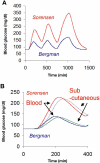Single walled carbon nanotubes as reporters for the optical detection of glucose
- PMID: 20144355
- PMCID: PMC2771526
- DOI: 10.1177/193229680900300204
Single walled carbon nanotubes as reporters for the optical detection of glucose
Abstract
This article reviews current efforts to make glucose sensors based on the inherent optical properties of single walled carbon nanotubes. The advantages of single walled carbon nanotubes over traditional organic and nanoparticle fluorophores for in vivo-sensing applications are discussed. Two recent glucose sensors made by our group are described, with the first being an enzyme-based glucose sensor that couples a reaction mediator, which quenches nanotube fluorescence, on the surface of the nanotube with the reaction of the enzyme. The second sensor is based on competitive equilibrium binding between dextran-coated nanotubes and concanavalin A. The biocompatibility of a model sensor is examined using the chicken embryo chorioallantoic membrane as a tissue model. The advantages of measuring glucose concentration directly, like most optical sensors, versus measuring the flux in glucose concentration, like most electrochemical sensors, is discussed.
(c) 2009 Diabetes Technology Society.
Figures








Similar articles
-
Single-walled carbon nanotube-based near-infrared optical glucose sensors toward in vivo continuous glucose monitoring.J Diabetes Sci Technol. 2013 Jan 1;7(1):72-87. doi: 10.1177/193229681300700109. J Diabetes Sci Technol. 2013. PMID: 23439162 Free PMC article. Review.
-
In vivo fluorescence detection of glucose using a single-walled carbon nanotube optical sensor: design, fluorophore properties, advantages, and disadvantages.Anal Chem. 2005 Dec 1;77(23):7556-62. doi: 10.1021/ac0511997. Anal Chem. 2005. PMID: 16316162
-
Single-walled carbon nanotubes as near-infrared optical biosensors for life sciences and biomedicine.Biotechnol J. 2015 Mar;10(3):447-59. doi: 10.1002/biot.201400168. Epub 2015 Feb 13. Biotechnol J. 2015. PMID: 25676253 Review.
-
Carbon nanotubes: a powerful bridge for conductivity and flexibility in electrochemical glucose sensors.J Nanobiotechnology. 2023 Sep 7;21(1):320. doi: 10.1186/s12951-023-02088-7. J Nanobiotechnology. 2023. PMID: 37679841 Free PMC article. Review.
-
Comparative analysis of single-walled and multi-walled carbon nanotubes for electrochemical sensing of glucose on gold printed circuit boards.Mater Sci Eng C Mater Biol Appl. 2018 Sep 1;90:273-279. doi: 10.1016/j.msec.2018.04.072. Epub 2018 Apr 25. Mater Sci Eng C Mater Biol Appl. 2018. PMID: 29853092
Cited by
-
Angiogenesis in the Avian Embryo Chorioallantoic Membrane: A Perspective on Research Trends and a Case Study on Toxicant Vascular Effects.J Cardiovasc Dev Dis. 2020 Dec 5;7(4):56. doi: 10.3390/jcdd7040056. J Cardiovasc Dev Dis. 2020. PMID: 33291457 Free PMC article. Review.
-
Overview of fluorescence glucose sensing: a technology with a bright future.J Diabetes Sci Technol. 2012 Nov 1;6(6):1242-50. doi: 10.1177/193229681200600602. J Diabetes Sci Technol. 2012. PMID: 23294768 Free PMC article. Review.
-
Diabetes treatment in 2025: can scientific advances keep pace with prevalence?Ther Adv Endocrinol Metab. 2012 Oct;3(5):163-73. doi: 10.1177/2042018812465639. Ther Adv Endocrinol Metab. 2012. PMID: 23185688 Free PMC article.
-
Glucose Oxidase Coupling with Pistol-Like DNAzyme Based Colorimetric Assay for Sensitive Glucose Detection in Tears and Saliva.Appl Biochem Biotechnol. 2025 Jan;197(1):534-544. doi: 10.1007/s12010-024-05046-7. Epub 2024 Aug 29. Appl Biochem Biotechnol. 2025. PMID: 39207679
-
The Progress of Glucose Monitoring-A Review of Invasive to Minimally and Non-Invasive Techniques, Devices and Sensors.Sensors (Basel). 2019 Feb 15;19(4):800. doi: 10.3390/s19040800. Sensors (Basel). 2019. PMID: 30781431 Free PMC article. Review.
References
-
- Diabetes atlas. 2nd ed. International Diabetes Federation; 2003.
-
- The Diabetes Control and Complications Trial Research Group. The effect of intensive treatment of diabetes on the development and progression of long-term complications in insulin-dependent diabetes-mellitus. N Engl J Med. 1993;329(14):977–986. - PubMed
-
- Barnett AH. Treating to goal: challenges of current management. Eur J Endocrinol. 2004;151(Suppl 2):T3–T7. discussion T29-30. - PubMed
-
- The absence of a glycemic threshold for the development of long-term complications. The perspective of the Diabetes Control and Complications Trial. Diabetes. 1996 Oct;45(10):1289–1298. - PubMed
-
- Wickramasinghe Y, Yang Y, Spencer SA. Current problems and potential techniques in in vivo glucose monitoring. J Fluoresc. 2004;14(5):513–520. - PubMed
Publication types
MeSH terms
Substances
LinkOut - more resources
Full Text Sources
Other Literature Sources
Medical

